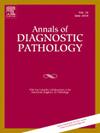Clinicopathologic features of histologic transformation in lung adenocarcinoma after treatment with epidermal growth factor receptor-tyrosine kinase inhibitors
IF 1.4
4区 医学
Q3 PATHOLOGY
引用次数: 0
Abstract
Background
Epidermal growth factor receptor (EGFR) tyrosine kinase inhibitors (TKIs) may lead to drug resistance, and the underlying mechanism may involve histologic transformations to small cell carcinoma (SCC), squamous cell carcinoma (SqCC), and sarcomatoid carcinoma (SC). Although there are reports regarding these transformations, comprehensive analyses are limited.
Methods
A total of 233 patients with primary lung adenocarcinoma treated with EGFR-TKIs were reviewed. Among them, 26 patients (11.1 %) showed histologic transformation.
Results
Eleven patients (42.3 %) showed SCC and SqCC transformations respectively, and four patients (15.4 %) showed SC transformation. The median time from TKI initiation to transformation was 19.8 months (6.8–51.4) for SCC, 45.3 months (2.4–101.5) for SqCC, and 11.8 months (6.8–15.7) for SC. The median overall survival (OS) was 41.8 months (12.5–78.9), 72.6 months (18.8–112.7), and 23.7 months (17.4–34.4), respectively. The survival from transformation was 12.3 months (2.1–28.3), 16.9 months (0.7–43.2), and 11.4 months (1.6–23.5), respectively. The most common mutations were TP53, PTEN, and RB1 in SCC; TP53 and RB1 in SqCC; and TP53 and KMT2D in SC. SC transformation had the worst OS, followed by SCC and SqCC (p < 0.001). This prognosis difference was also reflected in the time to transformation after EGFR-TKI treatment (p = 0.005). However, survival after transformation was not associated with tumor subtypes (p = 0.536).
Conclusions
The analysis of mutation profiles and survival outcomes revealed that the transformation subtype affects prognosis. Additionally, the time taken to undergo transformation is critical for patient outcomes.
表皮生长因子受体-酪氨酸激酶抑制剂治疗肺腺癌后组织学转变的临床病理特征
表皮生长因子受体(EGFR)酪氨酸激酶抑制剂(TKIs)可能导致耐药,其潜在机制可能涉及组织学转化为小细胞癌(SCC)、鳞状细胞癌(SqCC)和肉瘤样癌(SC)。虽然有关于这些转换的报告,但全面的分析是有限的。方法回顾性分析233例经EGFR-TKIs治疗的原发性肺腺癌患者的临床资料。其中26例(11.1%)出现组织学转变。结果6例(42.3%)患者分别表现为SCC和SqCC转化,4例(15.4%)患者表现为SC转化。从TKI起始到转化的中位时间SCC为19.8个月(6.8-51.4),SqCC为45.3个月(2.4-101.5),SC为11.8个月(6.8-15.7)。中位总生存期(OS)分别为41.8个月(12.5-78.9),72.6个月(18.8-112.7)和23.7个月(17.4-34.4)。转化生存期分别为12.3个月(2.1 ~ 28.3)、16.9个月(0.7 ~ 43.2)、11.4个月(1.6 ~ 23.5)。SCC中最常见的突变是TP53、PTEN和RB1;TP53和RB1在SqCC中的作用SC转化的OS最差,其次是SCC和SqCC (p <;0.001)。这种预后差异也反映在EGFR-TKI治疗后的转化时间上(p = 0.005)。然而,转化后的生存与肿瘤亚型无关(p = 0.536)。结论对突变谱和生存结果的分析表明,转化亚型影响预后。此外,接受转化所需的时间对患者的预后至关重要。
本文章由计算机程序翻译,如有差异,请以英文原文为准。
求助全文
约1分钟内获得全文
求助全文
来源期刊
CiteScore
3.90
自引率
5.00%
发文量
149
审稿时长
26 days
期刊介绍:
A peer-reviewed journal devoted to the publication of articles dealing with traditional morphologic studies using standard diagnostic techniques and stressing clinicopathological correlations and scientific observation of relevance to the daily practice of pathology. Special features include pathologic-radiologic correlations and pathologic-cytologic correlations.

 求助内容:
求助内容: 应助结果提醒方式:
应助结果提醒方式:


